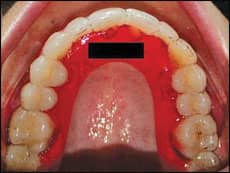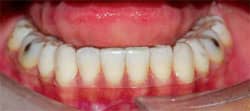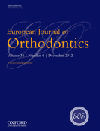by Frank Celenza, DDS
A new retainer is designed to be invisible and adjustable
 |
The advent of clear aligner therapy in orthodontics has brought on a new wave of orthodontic treatment, and brought with it a whole new patient population. The acceptance of Invisalign as a viable modality in adult orthodontics has opened the way for the treatment of patients who might not have otherwise elected to proceed with orthodontic therapy. It has introduced a more cosmetic and comfortable treatment alternative to these select patients, and has also proven to be effective and convenient.
However, the dictates of retention—and, frequently, long-term retention—remain. Further, these dictates often require a level of compliance and commitment that is not very different from what was required during the active treatment phase, if the results are to be maintained. As a result, orthodontists need retainers that are at once comfortable, accurate, and durable. As an added challenge, these retainers need to be cosmetic, if not invisible, because that is what these patients became accustomed to during active therapy.
 |
| Figure 1: A laboratory model with a typical example of a Clear Fusion Hybrid retainer. |
 |
| Figure 2: A pair of Clear Fusion Hybrid retainers (maxillary at left and mandibular at right). In this case, the acrylic portion is colored. Custom coloring and patterns are available, as with conventional acrylic retainers |
 |
| Figure 3: A clinical photo of a maxillary Clear Fusion Hybrid retainer in place. The delineation between the red acrylic palatal portion and the clear acetate portion is readily evident. |
 |
| Figure 4: A frontal view of a mandibular Clear Fusion Hybrid retainer in place. |
Retention Options
Invisalign offers a cosmetic and comfortable retention system by providing a duplicate of the last aligner stage used in the active phase of treatment. This retainer is, however, made from a slightly thicker and, consequently, stiffer and more durable clear thermoplastic than the last aligner. It is intended to last longer than the 2-week protocol for which the active aligners were designed. From the author’s clinical experience, the Invisalign retainer has frequently proven not to be durable enough. Invisalign has addressed the issue through the introduction of the Vivera program, which provides patients with a duplicate replacement retainer every 3 months.
Although this solution is attractive to many patients, there remain certain disadvantages, in the eyes of this author, to using this retention scheme. The main disadvantage of the Invisalign retainer system (and for that matter, the identical Vivera system) is that these appliances are static and not adjustable. Although they can be trimmed to adjust for potential soft-tissue impingements and the like, there is no compensation for other inaccuracies, such as actual tooth position. Further, as these retainers are fabricated from a treatment projection (the last or any specified stage in a ClinCheck proposal), and not from a model or impression of the actual result, there can easily be, and often is, a variation between this depiction and the actual results achieved. Consequently, an inherent lack of accuracy is present in this retention system that cannot be corrected by adjustment of the appliance.
More traditional retainer systems, such as Hawleys and other acrylic and wire appliances, have been able to overcome this adjustability issue by virtue of the wire clasps and labial bows that stabilize and activate them. Orthodontists have become adept at adjusting these auxiliaries, and even use such devices as active appliances in certain applications. Additionally, the construction of these traditional retainers was always achieved from an impression of the actual result. Nevertheless, a traditional acrylic and wire retainer is not usually aesthetically acceptable to a patient who was treated with clear shell aligners. Even though these more conventional retainers have proven to be very durable, they have not met with acceptance by patients weaned on nearly invisible appliances, since the retainer is far more noticeable than the active appliance was.
Clear Fusion Hybrid
The evolution of retainers and their design has resulted in a new development, a “hybrid retainer” that meets many of the demands of the new generation of orthodontic therapy. The Clear Fusion Retainer (patents pending) combines many of the advantages of both of the aforementioned designs to satisfy the demands of both the patient and practitioners.
The Clear Fusion Retainer is termed a “hybrid retainer” because it is the product of the fusion of the clear shell design and the acrylic wire type—although devoid of any metal clasps. The hybrid design gains strength by virtue of its fusion to the lingual, acrylic portion of the retainer. This portion is made of thicker conventional orthodontic acrylic. Perhaps most importantly, the dilemma of accuracy is addressed in this design, and the problem of nonadjustability is solved by the method of this retainer’s fabrication. The Clear Fusion retainer is constructed from an impression of the actual end result, not from a projection of the intended result. This leads to a retainer that fits precisely.
Moreover, as all the visible areas (labial and occlusal surfaces) of the Clear Fusion retainer are composed of clear shell acrylic, the appliance is as cosmetic or invisible as other clear retainer systems. Further, by virtue of the stronger acetate polymer system, and the lingual or palatal acrylic adaptation and fusion, a very stiff and durable result is achieved. It has been my experience that patients are immediately aware of a very intimate and secure fit of the Clear Fusion retainer immediately at initial fitment.
The Clear Fusion retainer can be applied to any case type, regardless of whether the active appliance was fixed or removable. All that is required is an accurate impression of the post-treatment result. Consequently, a scheme must be devised to obtain this impression, in the case of fixed appliance mechanotherapy, because impressing with the fixed appliances in place is not acceptable. Too much impression distortion can result, and the removal of brackets on a model results in further inaccuracy in approximating the teeth’s natural contours. Consequently, this author prefers to fabricate, at the time of debonding, a temporary conventional suck-down appliance (Essix or Tru-Tain type) that the patient is instructed to wear while the Clear Fusion retainer is being fabricated from a fresh impression of the newly debonded dentition. The turnaround time for this lab step is reliably 1 week (from Tortorici Orthodontic Lab, Port Jefferson Station, NY). The Clear Fusion retainer also offers the option of customized colors and patterns available in the acrylic aspect of the appliance.
|
For more information on the companies mentioned here, visit our online Buyer’s Guide. |
Lastly, it must be noted that the evolution of the Clear Fusion retainer continues. New versions that take advantage of the stability and rigidity of the appliance have arisen, with active auxiliaries such as jack screws embedded in the acrylic portion of the appliance. Taking advantage of the retention offered by the clear shell portion, these active hybrid appliances are showing great promise in applications such as rapid palatal expansion and many other variations.
In conclusion, new developments in material sciences result in new devices, designs, and applications in all aspects of life. The advent of the Clear Fusion Retainer is a logical and effective development in orthodontic retainer and removable appliance design that has resulted from the hybridization of conventional acrylic and clear shell appliances. These new hybrid retainers seem to incorporate the advantages of both in their construction.
Frank Celenza, DDS, is a certified dual specialist in the fields of both orthodontics and periodontics. He has a private practice in New York. He has written many scientific papers and textbook chapters, has been involved in postgraduate teaching at New York University for more than 20 years, and is a speaker at scientific meetings worldwide. He can be reached at










